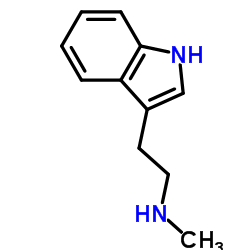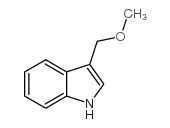526-31-8
| Name | Nα-methyl-L-tryptophan |
|---|---|
| Synonyms |
a-Methylamino-b-(3-indole)propionic Acid
N-ME-TRYPTOPHAN L-N-Methyltryptophan N-Methyl-L-tryptophan L-Tryptophan, N-methyl- H-METRP-OH L-Abrine Abrine L-2-methyltryptophan EINECS 208-388-5 ABRINE,L N-methyl-tryptophan N-α-Methyl-L-trytophan N(α)-methyl-L-tryptophan N(α)-methyl-L-tryptophan zwitterion N(alpha)-methyl-L-tryptophan MFCD00005645 Nα-Methyl-L-tryptophan N-ME-TRP-OH HCL N-ME-TRP-OH |
| Description | L-(+)-Abrine, a lethal albumin found in Abrus precatorius seeds, is an acute toxic alkaloid and chemical marker for abrin. |
|---|---|
| Related Catalog | |
| In Vitro | L-(+)-Abrine is a marker for abrin poisoning. A strong indication for abrin poisoning is the presence of the chemical maker L-(+)-Abrine, which can survive metabolism in significant amounts making it detectable in human urine[1]. |
| In Vivo | Abrin is a toxic protein found in the jequirity seed. L-(+)-Abrine (L-Abrine) is also found in the jequirity seed and can be used as a biomarker for abrin exposure. An animal study is designed to monitor the excretion and recovery of L-(+)-Abrine in 20 rats. The animals are exposed to one of three concentrations of L-(+)-Abrine, a single high concentration of L-tryptophan, or no agent (control). The low L-(+)-Abrine dose corresponds to 0.63 LD50 i.p. abrin in mice, assuming a concentration ratio of 1:4 of abrin to L-(+)-Abrine and an LD50 for abrin of 20 μg/kg. The mid and high L-(+)-Abrine (250 and 400 μg/kg) doses are included to ensure that the target analyte can be detected and tracked over the course of the experiment[2]. |
| Animal Admin | Rats[2] Twenty male Wistar rats, approximately 6-7 weeks of age and weighing approximately 175-200 g upon receipt, are used. A total of 12 rats are dosed intramuscularly with L-(+)-Abrine at 0.63, 3.13, and 5 times the expected Abrin LD50 of 20 μg/kg. Although no toxin is used here, the concentration of the biomarker is increased by a factor of 4 to estimate an equivalent level of toxin, assuming that Labrine is present in rosary peas at a concentration four times greater that the toxin abrin. A total of 12 rats are dosed intramuscularly with L-(+)-Abrine: four at approximately 50 μg/kg body weight (bw), four at 250 μg/kg bw, and four at 400 μg/kg bw. Four control rats are dosed with water, which is the vehicle for all dosing experiments. Another four rats are dosed intraperitoneally with 20,000 μg/kg L-tryptophan to verify that endogenous L-tryptophan is not metabolized to L-(+)-Abrine[2]. |
| References |
| Density | 1.3±0.1 g/cm3 |
|---|---|
| Boiling Point | 439.1±35.0 °C at 760 mmHg |
| Melting Point | >300 °C (dec.)(lit.) |
| Molecular Formula | C12H14N2O2 |
| Molecular Weight | 218.252 |
| Flash Point | 219.4±25.9 °C |
| Exact Mass | 218.105530 |
| PSA | 65.12000 |
| LogP | 1.18 |
| Vapour Pressure | 0.0±1.1 mmHg at 25°C |
| Index of Refraction | 1.649 |
| Symbol |

GHS07 |
|---|---|
| Signal Word | Warning |
| Hazard Statements | H302-H312-H332 |
| Precautionary Statements | P280 |
| Personal Protective Equipment | dust mask type N95 (US);Eyeshields;Gloves |
| Hazard Codes | Xn: Harmful; |
| Risk Phrases | R20/21/22 |
| Safety Phrases | S36 |
| RIDADR | NONH for all modes of transport |
| WGK Germany | 3 |
| HS Code | 2933990090 |
| Precursor 0 | |
|---|---|
| DownStream 2 | |
| HS Code | 2933990090 |
|---|---|
| Summary | 2933990090. heterocyclic compounds with nitrogen hetero-atom(s) only. VAT:17.0%. Tax rebate rate:13.0%. . MFN tariff:6.5%. General tariff:20.0% |




